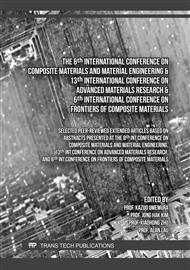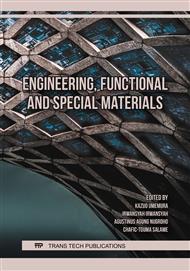[1]
Korolev E.V., Tarasov R.V., Makarova L.V., Samoshin A.P., Inozemtsev S.S., Tech. Substantiation of the choice of the method of nanomodification of asphalt concrete mixtures. Bulletin of the Belgorod State Technological University. V.G. Shukhov. Vol. 4 (2012), pp.40-43 (In Russian).
Google Scholar
[2]
Inozemtcev S.S., Korolev E.V. Increasing the weathering resistance of asphalt by nanomodification. Materials Science Forum. Vol. 945 (2019), pp.147-157.
DOI: 10.4028/www.scientific.net/msf.945.147
Google Scholar
[3]
Ghosh Swapan Kumar. Self-healing materials: fundamentals, design Strategies, and applications (1st ed.). Weinheim: Wiley. VCH (2009), p.307.
Google Scholar
[4]
Wiktor V., Jonkers H.M. Bacteria-based concrete: From concept to market. Smart Materials and Structures. Vol. 25 Issue 8 (2016), 084006.
DOI: 10.1088/0964-1726/25/8/084006
Google Scholar
[5]
Inozemtcev S.S., Korolev E.V. Review of Road Materials Self-healing: Problems and Perspective. IOP Conference Series: Materials Science and Engineering. 855(1) (2020), 012010.
DOI: 10.1088/1757-899x/855/1/012010
Google Scholar
[6]
Schlangen E., Sangadji S. Addressing infrastructure durability and sustainability by self healing mechanisms - Recent advances in self healing concrete and asphalt. Procedia Engineering. Vol. 54 (2013), pp.39-57.
DOI: 10.1016/j.proeng.2013.03.005
Google Scholar
[7]
Inozemtcev S.S., Korolev E.V. Technological Features of Production Calcium-Alginate Microcapsules for Self-Healing Asphalt. MATEC Web of Conferences. 251 (2018), 01008.
DOI: 10.1051/matecconf/201825101008
Google Scholar
[8]
Jonkers H.M., Thijssen A., Muijzer G., Copuroglu O., Schlangen E. Application of bacteria as self-healing agent for the development of sustainable concrete. Ecological engineering. Vol. 36 Issue 2 (2010), pp.230-235.
DOI: 10.1016/j.ecoleng.2008.12.036
Google Scholar
[9]
Wang J., Snoeck D., Van Vlierberghe S., Verstraete W., De Belie N. Application of hydrogel encapsulated carbonate precipitatingbacteria for approaching a realistic self-healing in concrete. Construction Building Materials. Vol. 68 (2014), p.110–119.
DOI: 10.1016/j.conbuildmat.2014.06.018
Google Scholar
[10]
Feng X. Self-healing mechanism of a novel cementitious composite using microcapsules. Proc. Int. Conf. on Durability of Concrete Structures. (2008), pp.195-204.
Google Scholar
[11]
Su J.F., Schlangen E., Qiu J. Design and construction of microcapsules containing rejuvenator for asphalt. Powder technology. Vol. 235 (2013), pp.563-571.
DOI: 10.1016/j.powtec.2012.11.013
Google Scholar
[12]
Raquel Casado Barrasaa, Víctor Blanco Lópeza, Carlos Martín-Portugués Montoliua, Verónica Contreras Ibáñezb, Josefina Pedrajasc, Julio Santarénd Addressing durability of asphalt concrete by self-healing mechanism. Procedia - Social and Behavioral Sciences. Vol. 162 (2014), pp.188-197.
DOI: 10.1016/j.sbspro.2014.12.199
Google Scholar
[13]
Su J.F., Schlangen E. Synthesis and physicochemical properties of novel high compact microcapsules containing rejuvenator applied in asphalt. Chemical Engineering Journal. 2012. Vol. 198-199. Pp. 289-300.
DOI: 10.1016/j.cej.2012.05.094
Google Scholar
[14]
Bin Xue, Huifeng Wang, Jianzhong Pei, Rui Li, Jiupeng Zhang, Zepeng Fan Study on self-healing microcapsule containing rejuvenator for asphalt. Construction and Building Materials. Vol. 135 (2007), pp.641-649.
DOI: 10.1016/j.conbuildmat.2016.12.165
Google Scholar
[15]
Al-Mansooria T., Micaeloabc R., Artamendid I., Norambuena-Contrerasae J., Garcia A. Microcapsules for self-healing of asphalt mixture without compromising mechanical performance. Construction and Building Materials. Vol. 155 (2017), pp.1091-1100.
DOI: 10.1016/j.conbuildmat.2017.08.137
Google Scholar
[16]
Inozemtcev S., Korolev E. Surface modification of mineral filler using nanoparticles for asphalt application. MATEC Web of Conferences. 196(10) (2018), 04052.
DOI: 10.1051/matecconf/201819604052
Google Scholar
[17]
Inozemtcev S.S., Korolev E.V., Do T.T. Thermal And Mechanical Properties Of Calcium Alginate Capsules For Self-Healing Asphalt Concrete. Materials Science Forum. Vol. 1041 (2021), pp.101-106.
DOI: 10.4028/www.scientific.net/msf.1041.101
Google Scholar
[18]
Bin Xue, Huifeng Wang, Jianzhong Pei, Rui Li, Jiupeng Zhang, Zepeng Fan Study on self-healing microcapsule containing rejuvenator for asphalt. Construction and Building Materials. Vol. 135 (2007), p.641–649.
DOI: 10.1016/j.conbuildmat.2016.12.165
Google Scholar
[19]
Xua S., Tabaković A., Liua X., Schlangena E. Calcium alginate capsules encapsulating rejuvenator as healing system for asphalt mastic. Construction and Building Materials. Vol. 169 (2018), pp.379-387.
DOI: 10.1016/j.conbuildmat.2018.01.046
Google Scholar
[20]
Bhasin A., Palvadi S., Little D. Influence of Aging and Temperature on Intrinsic Healing of Asphalt Binders. Transportation Research Record Journal of the Transportation Research Board. Vol. 2207. Issue 1 (2011), pp.70-78.
DOI: 10.3141/2207-10
Google Scholar
[21]
Bhasin A., Palvadi S., Little D. Influence of Aging and Temperature on Intrinsic Healing of Asphalt Binders. Transportation Research Record Journal of the Transportation Research Board. Vol. 2207. Issue 1. (2011), pp.70-78.
DOI: 10.3141/2207-10
Google Scholar
[22]
Tang J., Liu Q., Wu Sh., Ye Q., Sun Y., Schlangenc E. Investigation of the optimal self-healing temperatures and healing time of asphalt binders. Construction and Building Materials. Vol. 113 (2016), pp.1029-1033.
DOI: 10.1016/j.conbuildmat.2016.03.145
Google Scholar
[23]
Xie W., Castorena C., Wang Ch., Kim Y.R. A framework to characterize the healing potential of asphalt binder using the linear amplitude sweep test. Construction and Building Materials. Vol. 154. (2017), pp.771-779.
DOI: 10.1016/j.conbuildmat.2017.08.021
Google Scholar
[24]
Korolev E.V., Inozemtcev S.S., Smirnov V.A. Nanomodified bitumen composites: solvation shells and rheology. Advanced Materials, Structures and Mechanical Engineering. Proceedings of the International Conference on Advanced Materials, Structures and Mechanical Engineering. (2016), pp.393-398.
DOI: 10.1201/b19693-84
Google Scholar
[25]
Sivukhin D.V. General course of physics. Thermodynamics and molecular physics. Volume II M.: Nauka, 591 p. (1990).
Google Scholar
[26]
Fisher H. Self repairing materials – dream or reality? Natural Science. Vol. 2. No. 8 (2010), pp.873-901.
Google Scholar
[27]
Qui J., M.F.C. van de Ven, Wu S., Molenaar A.A.A. Investigation of self healing capability of bituminous binders. Road Materials Pavement Design. Vol. 10. Issue 1 (2009), pp.81-94.
DOI: 10.3166/rmpd.10hs.81-94
Google Scholar
[28]
Phillips M.C. Multi-step models for fatigue and healing, and binder properties involved in healing. In: Eurobitume workshop on performance related properties for bituminous binders, Luxembourg. Paper no. 115 (1998).
Google Scholar
[29]
Evdokimov Yu.M. Adhesion. From macro and micro levels to nanosystems. M.: FGBOU VPO MGUL. 208 p (2011). (In Russian).
Google Scholar
[30]
Li Xiang, Jiawen Zhang, Jingsi Chen, and Hongbo Zeng .Fundamentals and Advances in the Adhesion of Polymer Surfaces and Thin Films. Langmuir. Vol. 35. Issue 48 (2019), p.15914–15936.
DOI: 10.1021/acs.langmuir.9b02123
Google Scholar
[31]
Adhesives Technology Handbook (Second Edition) Edited by and Sina Ebnesajjad. 363 p. (2009).
Google Scholar
[32]
Bikerman Ya.O. New ideas about the strength of adhesive bonds in polymers. Advances in chemistry. V. 41. No. 8. (1972), pp.1431-1464. (In Russian).
Google Scholar
[33]
Voyutsky S.S. Autohesion and adhesion of high polymers. Moscow: Gostekhizdat. 1960. 244 p. (In Russian).
Google Scholar
[34]
Laurila T., Vuorinen V., Mattila T.T., Turunen M., Paulasto-Kröckel M., Kivilahti J.K. Interfacial Adhesion in Polymer Systems. Interfacial Compatibility in Microelectronics. Pp. 101-133. (2012).
DOI: 10.1007/978-1-4471-2470-2_5
Google Scholar
[35]
Moskvitin N.I. Physical and chemical bases of gluing and sticking processes. Moscow: Timber industry. 248 p (1964) (In Russian).
Google Scholar
[36]
Deryagin B.V., Krotova N.A., Smilga V.P. Adhesion of solids, M., Nauka. 278 p. (1973) (In Russian).
Google Scholar



